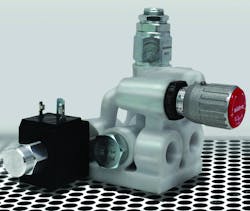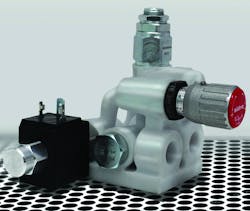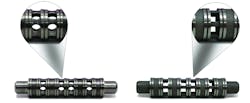3D Printing Coming to Hydraulics
One advantage of hydraulics technology is its high power density. Hydraulic pumps are typically a small fraction the size of the electric motors that drive them, and the size and weight differential between pumps and gas or diesel engines is even more pronounced. An even bigger advantage is with actuators. Hydraulic cylinders only a few inches in diameter can generate forces to lift thousands of pounds, crush rock and concrete, or form high-strength steel into rugged components.
Of course, another advantage of hydraulics is its ability to control direction, speed, torque, and force using anything from simple manually operated valves to sophisticated electronic controls to command valves automatically. And even though electronic control of hydraulic valves continues to advance, processes improvements for manufacturing the valves themselves have not been as dramatic. But that has started to change.
Where We Are and May Be Going
Cartridge valve technology is widely used to integrate several control functions into a single manifold. Centrally locating multiple valves within a manifold can dramatically reduce space, weight, and cost compared to conventional circuits using line-mounted valves, hose, and connectors. But the space- and weight-conserving advantages of cartridge valves and manifolds (integrated hydraulic circuits) leave room for improvement. That’s because many of the passageways in manifolds must be located to prevent cross-drilled channels or provide enough material between channels for adequate strength.
Three dimensional printing overcomes these limitations by positioning flow channels precisely where they are needed and in a variety of shapes and sizes. This means flow channels can be spaced closer together than with conventional manifolds, which makes the finished product more compact and lighter. Furthermore, passageways connecting two or more internal channels don’t have to be machined from outside the manifold and subsequently plugged to prevent fluid from flowing out.
However, 3D printing isn’t limited to manifolds. Valve components themselves can also benefit from 3D printing. For example, valve spools usually contain circular flow paths, primarily because machine tools use rotating cutting tools. Instead, making flow paths with square cross-sectional areas instead of circular could increase flow capacity by 20%, because of the larger area of a square compared to a circle of the same width.
Additive Manufacturing
According to additivemanufacturing.com, 3D printing is a subset of additive manufacturing, which also encompasses, rapid prototyping, direct digital manufacturing, layered manufacturing, and additive fabrication. The website explains that additive manufacturing builds three-dimensional objects by adding layer-upon-layer of material, whether its material is plastic, metal, concrete, or some day, even human tissue. Once a CAD model is produced, the additive manufacturing equipment transfers data from the model and generates successive layers of powder, wire, sheet, or other material layer-by-layer to fabricate a 3D object.
This 3D-printed hydraulic valve block is made of stainless steel for controlling a single-acting cylinder. The process uses a computer-controlled laser to melt stainless steel powder layer by layer. (Image courtesy of Aidro SrL).
Alberto Tacconelli, Managing Director at Aidro SrL, Taino, Italy, explains that 3D printed components are best suited to highly specialized applications, not large production volumes. Aidro designs and manufactures conventional and 3D printed hydraulic components. “With additive manufacturing, we can create highly customized components that are smaller, lighter, and often with higher efficiency or performance than those built using conventional techniques.”
Tacconelli continues, “Because of its ability to build internal features and passageways, additive manufacturing is well suited for the design and manufacture of manifolds. Our internal channels of the valve block (shown on page 12) are optimized for greater flow within a smaller space. Furthermore, the potential for leaks is eliminated because auxiliary drillings (hole plugs) are not needed.
Because it is not bound by conventional manufacturing techniques, 3D printing can produce components with unconventional shapes. Tthe benefits can be realized in components such as this valve spool with square ports for greater flow capacity than round ports of the same width. (Image courtesy of Aidro SrL)
“We believe the main advantages in hydraulics are:
- Realization of concepts that could not be accomplished using traditional techniques.
- Reduce weight, space, and material.
- New configurations to reduce the complexity of line connections.
- Fast prototyping and the possibility to have different prototypes for the same project.
- Shorter production time—a few hours instead of days.
- Choice between different metals: AISI 304 and 316L stainless steel, aluminum and titantium alloys, plus new materials still under development
- Higher performance and elimination of potential leakage (no plugs needed).”



